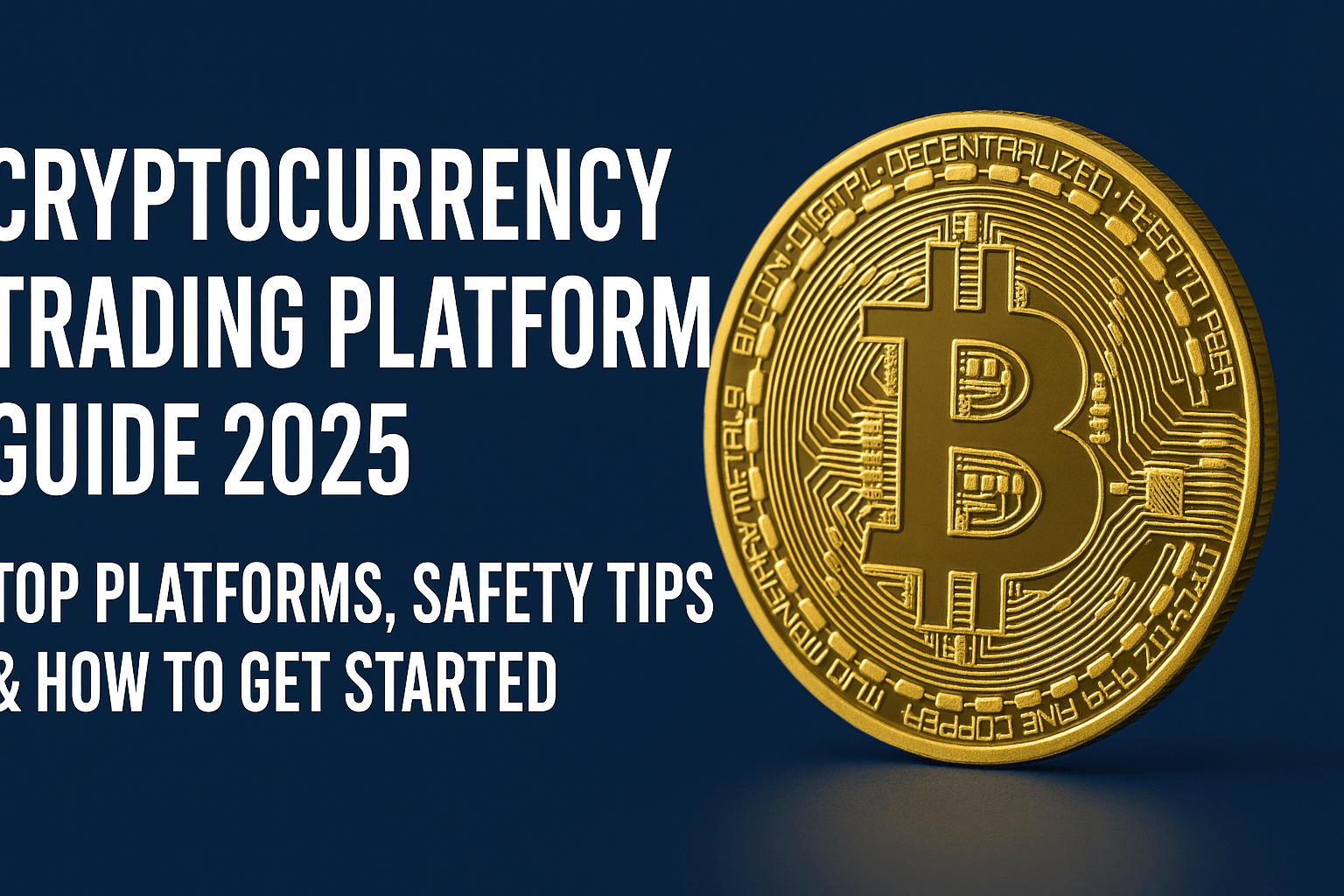Cryptocurrency trading is booming in the US, more people are seeing cryptos as a new way to invest, save and grow their money. In 2025 buying and selling crypto has never been easier—but choosing the right platform still matters. This guide will show you how these platforms work, how to get started, the top picks for 2025 and how to keep your investments safe.
We’ll also share deep insights about regulations, fees, future trends and tips for beginners. Whether you’re just starting or looking to switch platforms, this article is for you. Let’s get started.
Crypto Trading Platforms Explained
A cryptocurrency trading platform is an online website or app where you can easily buy and sell, and store digital coins like Bitcoin, Ethereum, and many others. It works like a middleman, linking buyers and sellers in real time so you can trade quickly and without any inconvenience. Think of it as a stock trading app—but for crypto instead of company shares.
Many platforms also have built in wallets to keep your coins safe. Some go further, offering ways to earn interest, stake your crypto or use advanced tools for serious traders. The best trading platform should be secure, easy to use and legally approved to operate in your country—especially if you’re in the USA.
How Does a Crypto Trading Platform Work?
When you log into a trading platform, you get access to a dashboard. Here you can see the prices of different cryptocurrencies. You can pick what you want to buy or sell. Once you place an order, the platform matches you with someone else either a buyer or a seller. This is called the order matching process.
Some platforms have more advanced tools like limit orders or stop-loss settings. Others offer simple options for beginners like “buy now” buttons. After buying crypto, it can stay in your online wallet on the platform or you can transfer it to a private wallet for more security.
Types of Cryptocurrency Trading Platforms (Centralized vs Decentralized)
There are two types of trading platforms: Centralized && Decentralized. Centralized platforms, like Kraken or Coinbase, are run by a company. They manage user accounts, customer support and built-in wallets. These are popular in the USA and easy to use.
Decentralized platforms don’t have a central authority. Users trade directly with each other using smart contracts. They usually don’t require account sign-ups or KYC but can be complex for beginners.
Here’s a quick comparison:
| Feature | Centralized | Decentralized |
| Control | Company-operated | User-operated (peer-to-peer) |
| KYC Required | Yes | No |
| Easy to Use | Yes | No |
| Speed | Fast | Slower |
| Security | Mixed (custodial) | High (non-custodial) |
The Key Features to Look for in a Good Trading Platform
Before you pick a crypto trading platform, it’s important to look at key features. First, check if it is available and legal in the USA. It should follow all local laws and offer strong security like two-factor authentication, cold wallet storage, and encryption.
Next, see what coins are available. A good platform supports many cryptocurrencies and trading pairs. The user interface should be fast and clean. Clean and fast. Instant buy. Staking. Mobile apps. Customer support. If you are a beginner, simple tools are better. Advanced traders may want more features like margin trading and chart analysis.
Top 7 Cryptocurrency Trading Platforms in 2025 (With Pros & Cons)
Let’s look at the top platforms for U.S. users in 2025. These are trusted by millions, safe, and legal in the USA.
| Platform | Pros | Cons |
| Coinbase | Easy for beginners, high security | Higher fees |
| Kraken | Great support, advanced tools | Slower interface |
| Binance.US | Low fees, many coins | Limited features vs Binance.com |
| Gemini | Regulated in the USA, insured wallets | Fewer coins |
| eToro USA | Social trading, good for beginners | Limited crypto choice |
| Robinhood | No fees, easy interface | No crypto transfers allowed |
| Uphold | Many coins, includes metals/stocks trading | UI can feel cluttered |
How to Get Started Trading on a Cryptocurrency Platform (Step-by-Step for Beginners)
It’s easier than ever to get started. First, choose a platform that is available in your state. Go to their website or download their app. Create an account with your name, email and password. You’ll need to verify your identity with a driver’s license. This is required by US law.
Next, fund your account with your bank account or card. Some platforms also accept PayPal or crypto deposits. Then go to the trade screen, choose the crypto you want and buy.
Cryptocurrency Trading Fees Explained: What You Must Know
Every platform charges different fees. These usually include trading fees (maker/taker), withdrawal fees, and sometimes deposit fees. Some even charge a spread, which is the difference between buying and selling prices.
Here’s a fee comparison table:
| Platform | Maker Fee | Taker Fee | Withdrawal Fee |
| Coinbase | 0.40% | 0.60% | Varies by coin |
| Kraken | 0.16% | 0.26% | Low, fixed rates |
| Binance.US | 0.10% | 0.10% | Very low |
| Gemini | 0.20% | 0.40% | Moderate |
Low fees matter for active traders. But for beginners, ease of use and safety are more important than saving a few cents.
How Safe Are Cryptocurrency Trading Platforms? (Security Tips Included)
Mostly platforms use strong safety tools like encryption, 2FA and cold storage. However no platform is 100% secure. Hacks have happened before. This is why it’s smart to move your coins to a cold wallet (offline wallet) if you’re not trading daily.
Be careful with phishing scams. Never click links in random emails. Always check the website URL. Use a unique passwords and enable all security features. If a platform offers insurance for stored crypto, that’s a plus.
Legal & Regulatory Status of Crypto Trading Platforms Worldwide
In the USA, crypto platforms must register with agencies like FINCEN and follow SEC rules. They are required to collect KYC data and report large transactions. Platforms that follow these rules are safer and better for long-term users.
Outside the USA, laws vary. Some countries ban crypto. Others fully allow it. Europe is creating strong new laws (MiCA). In Asia, Japan and South Korea regulate tightly. Always use platforms licensed in your country.
Future of Cryptocurrency Trading Platforms: Trends to Watch in 2025 and Beyond
In the 2025, we expect platforms to become more user-friendly. Many will add AI tools, better mobile apps, and more coins. Some may allow tokenized stocks, gold, or even real estate. We’ll also see better support for NFTs, staking, and Layer-2 chains.
Platforms will likely follow stricter rules in the future. This means more safety and less risk for users. But it could also mean more KYC and limits. The best platforms will balance security with freedom.
Conclusion: So Which Crypto Trading Platform is Right for You
Choosing the best crypto trading platform in 2025 is all about finding one that fits you. If you are a beginner Coinbase or Gemini might be the way to go for simplicity and strong United States regulations. More active traders might prefer Kraken or Binance. For the US lower fees and more advanced tools.
Whatever you choose make sure to check the platform security, fees and if it’s allowed in your state. The crypto market is full of opportunities but Caution and continuous learning can improve your trading decisions, but there’s always a risk of loss. Start from small invest, learn fast and never risk more than you can afford to lose.

